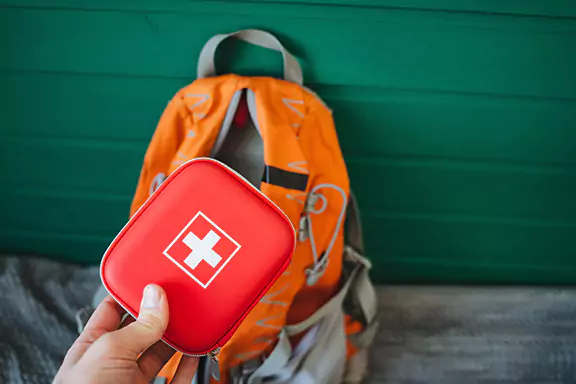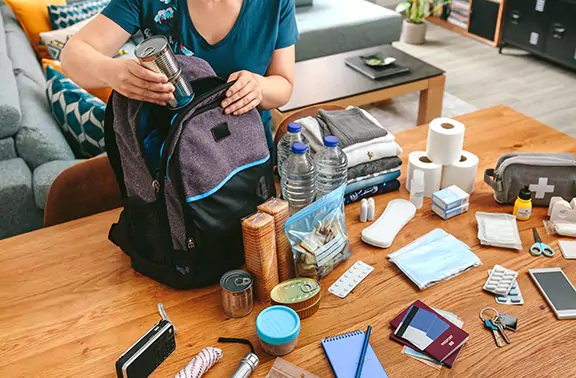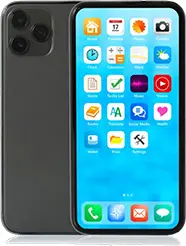Imagine this scenario: You’re at home when a natural disaster hits—a severe storm or an unexpected wildfire forces you to evacuate your neighborhood. You need to leave quickly and may not have access to your house for days. Having an emergency preparedness backpack packed and ready can make all the difference in staying safe and comfortable until you can return or find shelter. But what should you actually pack in that bag? What are the essential emergency supplies you’ll need? And how can you be sure you’re prepared for whatever may come?
This guide will walk you through the must-have items for your emergency kit, what’s good to have, where to buy or obtain the supplies, and tips on how to keep your backpack ready for action.
What You Need in Your Emergency Preparedness Backpack
When preparing your emergency preparedness backpack, it’s important to include both essential survival items and things that will make your experience more manageable. Here’s a breakdown:
Water and Food
Water: You’ll need at least one gallon per person per day for at least three days. If possible, include water purification tablets or a portable water filter as a backup.
Non-perishable food: Pack enough for three days, focusing on high-energy, easy-to-prepare items like protein bars, trail mix, canned goods, and freeze-dried meals. Make sure you have a can opener if you’re packing canned food.
First Aid Kit
A well-stocked first aid kit is crucial. Include the basics—bandages, antiseptic wipes, gauze, pain relievers, and adhesive tape. But also consider adding items like prescriptions (if applicable), tweezers, and any personal medications you need. If you have specific medical needs, make sure to include extra supplies, like an EpiPen or inhalers.
Personal Hygiene Items
Staying clean can help prevent infections and make your emergency situation more bearable. Pack hand sanitizer, moist towelettes, toothpaste, and a toothbrush. If you’re planning for longer-term emergencies, include a small towel, toilet paper, and a waste bag (for when toilets aren’t available). Personal hygiene is often overlooked, but it’s a must-have!
Shelter and Warmth
If you’re displaced from your home, having the means to stay warm and protected is essential. Pack a lightweight tent or tarp for shelter, along with emergency blankets or sleeping bags. If you’re in a cold climate, also include extra layers of clothing, such as warm socks and gloves. A space blanket can help insulate your body and keep you from getting hypothermic.
Identification and Cash
Always keep a copy of your identification in your emergency preparedness backpack, along with a backup credit card or some cash. In an emergency, you may not have access to ATMs or card readers, and having cash can be incredibly useful.
Chargers and Batteries
You’ll want to keep your devices charged for emergencies. Pack a portable charger or extra batteries for essential electronics, such as a flashlight, radio, or cell phone. If you’re including a cell phone, consider keeping a solar charger or hand-crank charger in your bag for extended power.
Emergency Tools
A few basic tools can be invaluable in an emergency situation. A multi-tool or a compact tool kit with things like scissors, a knife, and a whistle can help you stay prepared for anything. You might also want to include a flashlight, a pair of sturdy gloves, and a small shovel if you’re dealing with rough terrain or debris.
Important Documents
In case you need to prove your identity or access essential services, it’s important to have important documents in your emergency kit. This includes medical records, birth certificates, insurance policies, and family contact information. Store these documents in a waterproof bag to protect them from the elements.
Other Supplies for Specific Disasters
Depending on the type of disasters common in your area, you might want to include other specific items:
Dust mask for wildfires or air pollution.
Rain poncho or waterproof clothing for heavy rains or floods.
Fire extinguisher if you’re in an area prone to wildfires.

Where to Get Your Emergency Preparedness Backpack and Supplies
You can purchase emergency supplies from many stores, including big-box retailers like Walmart or Target, as well as specialized stores like REI or camping supply shops. Online retailers like Amazon also offer a variety of emergency preparedness items. Many stores even offer emergency kits that are pre-packed with essentials like a first aid kit, food, water, and more.
For more customized items, such as prescription medications, chargers, or specific tools, it’s best to assemble the backpack yourself. This allows you to tailor it to your family’s unique needs and ensure that every item is something you’ll use in a real emergency.
Storing and Maintaining Your Emergency Kit
Once you’ve packed your emergency preparedness backpack, storing it properly is just as important as packing it. Keep your bag in an easily accessible location—preferably somewhere near your home’s exit, like a hallway closet or near the garage door. If you’re keeping it in the car, make sure it’s in a cool, dry place, as extreme temperatures can degrade certain supplies.
Be sure to recheck your kit every 6-12 months. Items like food and water can expire, and batteries can lose their charge. Also, ensure that your prescriptions are up to date and that your family members’ needs are still met by the contents of the backpack.
Stay Connected with EASY Wireless
Getting prepared for an emergency is crucial, but staying connected is just as important. With EASY Wireless, you can stay in touch with loved ones and receive emergency updates with free cell phone service through the Lifeline Program.
What EASY Wireless Offers:
Free talk, text, and data: Perfect for accessing emergency updates, contacting loved ones, and coordinating assistance.
Eligibility through Government Benefits: Programs like SNAP, Medicaid, and LIHEAP qualify you for this essential service.
Visit one of our 30+ EASY Wireless stores in Oklahoma to sign up for FREE cell phone service, or enroll online.
Encourage your family and friends to apply and share this valuable resource. With EASY Wireless, you’ll always have peace of mind, knowing that you’re prepared and connected.
Prepare now to stay safe and connected!


